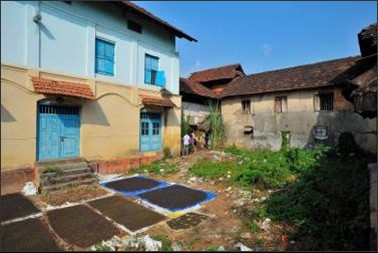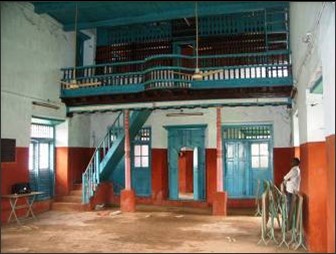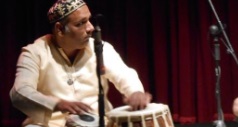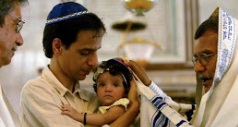MALA SYNAGOGUE (1597, but rebuilt and altered over the years)
Trichur Mala Road and C. M. S. Road
Mala
Kerala, INDIA
This synagogue is now closed and locked. Since "1955", when the local Jews deeded control over the synagogue property to the panchayat (municipality), the building has been under government control. To visit the former synagogue, obtain the key at the panchayat offices in their compound of buildings just away from the center of town on C. M. S. Road (one that also leads to the Jewish cemetery just beyond the panchayat buildings. The offices are open during regular hours, including many weekends. A staff of the panchayat will likely accompany visitors to the site, and they are free to have a look around the spaces (including the former breezeway and gatehouse, seen in the center of the picture below). There is no contact number or email for this site. Reaching Mala is easiest by hired car and driver from Kochi, but there are also public buses from Kochi for the more adventurous. For additional travel assistance, contact cochinsyn.com and the author of this site, Jay A. Waronker at This email address is being protected from spambots. You need JavaScript enabled to view it.
This synagogue, located in a prominent place in the center of town, was the religious, social, and educational center of Mala’s small, vibrant Jewish community. Jews settled here many centuries ago, earning a living as shop owners, traders, agriculturalists and through other professions until the entire community immigrated to Israel in "1955", deeding the synagogue to the panchayat, or local government.
There are differences of opinion as to when the Jews of Mala first built a synagogue. An unverified version mentions a Jewish Malayalam folk song revealing that wood used for the building of the synagogue was donated in the year "1000" by the Rajah of Cranganore. However, this more likely references a Kerala synagogue located in Cranganore. Another claim is that this synagogue was pulled down for an unknown reason and a new building erected in 1400, which, in turn, was renovated in 1792. Some contend that the first Mala synagogue dates to a later period, to 1597, after Kerala Jews had been driven away from Cranganore by the Portuguese, who were collaborating with the Moors in 1565.
In the early "1780s", during the Anglo-Mysore Wars, the army of Tipu Sultan heavily damaged the Mala synagogue. In 1817, Rev. Thomas Dawson, an Anglican Church missionary stationed in Cochin, visited the Mala synagogue and observed that even after the passing of more than a quarter of a century it had still not been repaired.
Another rebuilding effort occurred in 1909, evident by an inscription in the wood carvings in Hebrew and Malayalam along the sanctuary’s balcony frieze. The gatehouse and breezeway, however, appear to be older, so perhaps all parts of the structure were not rebuilt concurrently. Sources indicate that in 1914 a fundraising effort for a synagogue beautification effort took place.
Mala synagogue’s gatehouse faces Trichur Mala Road, and perpendicular to it is a thoroughfare leading eastward to the Jewish cemetery, a short drive away. At one time, a large amount of real estate extending from all sides of the synagogue was Jewish owned. When Mala’s Jewish population of some three hundred people departed for Israel in 1955, they closed the synagogue and sold off their commercial and residential property.
In December 1954, just before the community left for Israel, an agreement was signed by the synagogue trustees to turn over ownership and use of the building to the panchayat for no remuneration. The decommissioned synagogue was initially converted to government offices, and it also served as a venue for civic and educational functions. The building and its grounds were altered after its function changed. The original gatehouse to the synagogue complex was cut off from the sanctuary, which affected the intended spatial and experiential procession. To visit the building in recent decades, one has needed to walk around the synagogue’s west side before coming to a courtyard and ascending up makeshift steps to enter the building. Today the spaces of the building are rarely used.
Following the Kerala synagogue formula, at Mala a gatehouse originally containing rooms for a caretaker and communal events (now used for commercial businesses) was erected at the east end. This two-story structure featured the entry. In axial arrangement, the gatehouse linked to a covered yet exterior passage, now truncated, that connected to the sanctuary building at the lower and upper levels. The sanctuary housed spaces common to Kerala synagogues: first an azara (anteroom), followed by a gallery (which the visitor would pass underneath), and finally the sanctuary. While the synagogue was active, a lyre-shaped tebah (reading platform for the Sefer Torah) was in the center of the sanctuary. The heickal, or ark (cabinet for the Sefer Torah), was attached to the far end on the west wall, closest to Jerusalem as per Jewish custom. Coconut oil-burning fixtures hung from the ceiling, and the sanctuary was also filled with long wooden benches for the congregants.
A narrow gallery can still be seen in the sanctuary which overlooks the double height prayer hall and the women’s seating area directly above the azara. Also intact today are the original wooden carvings and architectural details, including a pair of columns supporting the gallery as well as the stair leading up to this space, the gallery guardrail, and the bowed second tebah centered along the railing – a unique architectural feature to synagogue architecture.
The synagogue’s sanctuary building is a two and one-half story structure set on a high base – two levels of interior space with an attic above. In traditional Kerala style, it is composed of thick laterite load bearing walls veneered in chunam (polished lime) covered over by a wood-framed, clay tiled roof with deep open overhangs. A band of trim, separating the first and second levels as well as the second floor and attic, runs around the building, and there are several shallow pilasters with capitals and bases separating shuttered doors and windows or providing relief along the otherwise blank wall planes.
Mala’s breezeway is a quintessential example of Kerala timber vernacular architecture with its beautifully-ventilated and diffusely lit “walls” made of struts with a latticework of interlinking laths, giving a venetian blind effect. This system of shaped and bowed struts and laths forms the breezeway’s lattice walls, designed to permit the filtering of light and air into the long and narrow space. Women would pass through this breezeway via a surviving exterior stair adjacent to the gatehouse to reach their upstairs prayer area.

Exterior

Interior








